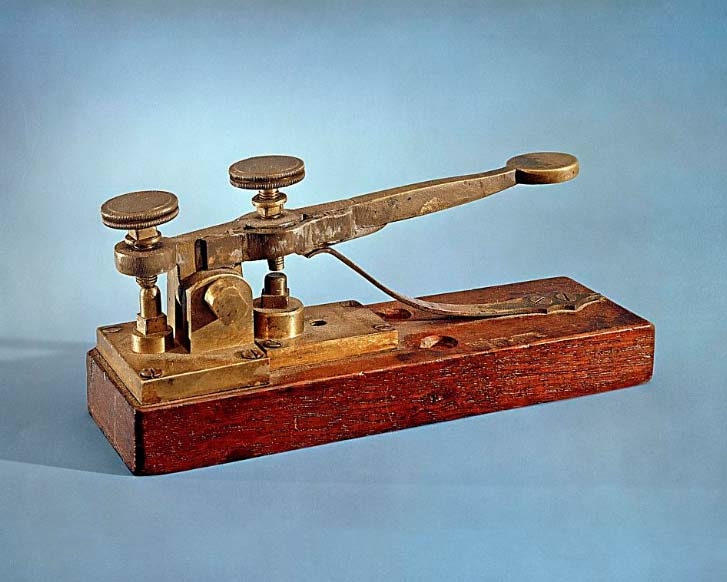Short and simple answer for Who invented the Morse code? Samuel Morse, along with his colleague Alfred Vail, invented Morse code in the early 1840s to be exact most say in 1837. This code revolutionized long-distance communication by translating text into a series of dots and dashes.
The Invention and Evolution of Morse Code

Early Beginnings
The story of Morse code’s inception is a tale of innovation, necessity, and the dawn of a new communication era. In the early 19th century, communication over long distances was slow and cumbersome. The most rapid form of long-distance communication was by horseback, which was naturally limited by distance and geography. Samuel Morse, initially a professional artist, became intrigued by the idea of electric telegraphy during a sea voyage in 1832. This interest was further fueled by personal tragedy when he received word of his wife’s sudden illness and subsequent death, and he was unable to reach her in time due to the slow communication methods of the day.
Determined to improve long-distance communication, Morse began experimenting with electromagnetism and the concept of transmitting information over wires. In 1835, he developed a prototype of an electromagnetic telegraph. This device could send signals over a wire by opening and closing an electric circuit, thereby generating electromagnetic pulses.
Morse’s encounter with Joseph Henry, an American scientist who had made significant advancements in electromagnetism, was pivotal. Henry’s work on electromagnets provided Morse with the technical foundation to extend the range of his telegraph system. However, the telegraph’s potential was limited without a standardized code to convey language.
Enter Alfred Vail, who joined Morse in 1837. Vail brought technical skills and innovation to the table, and together they developed the Morse code. This new system of communication was a set of unique patterns of dots and dashes that represented letters and numbers. It was an ingenious solution that transformed abstract electrical pulses into a readable, understandable language.
The first successful demonstration of the telegraph using Morse code was conducted by Morse and Vail in 1838. But it wasn’t until 1844 that the famous line “What hath God wrought” was sent from the Capitol in Washington, D.C., to Baltimore, marking the first official telegraph message transmitted over a long distance using Morse code.
The Code Itself
The Morse code is a method of encoding textual information into a series of on-off tones, lights, or clicks that can be directly understood by a skilled listener or observer without the need for equipment. The essence of Morse code lies in its simplicity and effectiveness, which has allowed it to remain in use even in the age of digital communication.
Basic Structure
- Dots and Dashes: Morse code translates each letter of the alphabet and each numeral into a series of dots (short signals) and dashes (longer signals). For example, the letter “A” is represented by a dot followed by a dash (·-), while “B” is a dash followed by three dots (-···).
- Spacing: The code relies not only on the dots and dashes but also on the spaces between them. The duration of a dot serves as the basic unit of time. A dash is equal to three dots in length. The space between symbols (dots and dashes) within a letter is one dot, between letters is three dots, and between words is seven dots.
Transmission and Reception
- Telegraph Key: Originally, Morse code was sent using a telegraph key, a type of switch that controlled the flow of electric current to a telegraph wire. By pressing down the key, the operator could complete the electrical circuit, sending a pulse of current down the line.
- Sound Interpretation: The receiving end of a telegraph line was equipped with a sounder, which produced clicks when the current was received. Skilled operators would interpret these clicks as dots and dashes, decoding them into text. Over time, experienced operators could “read” the Morse code by sound alone, without needing to write down the dot-dash sequences.
- Visual Interpretation: In some early systems, the Morse code was written down on a strip of paper by a machine called a telegraph register, which converted the electrical signals into written form.
Learning and Mastery v. Mnemonic Devices: To learn Morse code, operators often used mnemonic devices to memorize the various patterns. For instance, a common way to remember the code for the letter “F” (-··-) was to associate it with the rhythm of the phrase “did it dit.”
- Skill Development: Proficiency in Morse code required much practice. Operators needed to develop a keen ear for distinguishing between the different lengths of dots and dashes and the spaces between them.
Applications and Legacy
- Morse code was essential in the early days of radio. Before voice transmission was possible, all communication was done using Morse code.
- Today, Morse code is still used in some areas of radio communication, particularly by amateur radio enthusiasts. It is also sometimes used as an assistive communication method for people with severe movement or speech limitations.
Transmission Techniques
Originally, Morse code messages were sent by operators using a telegraph key, a switch that turned the electric current on and off. The operators needed to be skilled in creating the right sequence of dots and dashes to form words and sentences. The received signals were initially documented as marks on paper tape and later interpreted by sound.
Adoption and Adaptation
Morse code gained rapid popularity, especially after the first telegraph line was completed in the United States in 1844. The code underwent several modifications to accommodate different languages and applications, most notably the International Morse Code, which standardized the representation for each of the characters.
Morse Code in Modern Times
With the advent of more advanced technologies, the use of Morse code has declined in the field of communication. However, it still holds value in certain areas. It’s used in aviation and aeronautical navigation systems and remains a vital skill for amateur radio enthusiasts. The simplicity and effectiveness of Morse code in transmitting data over various mediums have ensured its continued relevance.
Samuel Morse’s invention of Morse code was a significant milestone in the history of communication. It paved the way for the modern era of connectivity, demonstrating the power of simple yet effective solutions in overcoming communication barriers. Morse code is more than just a series of dots and dashes; it’s a testament to human ingenuity and the quest for progress.


